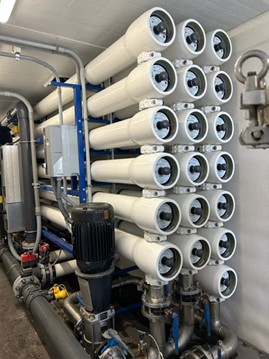Clean and safe water is a fundamental requirement for our well-being, yet the increasing presence of PFAS contaminants in industrial water sources remains a significant cause for alarm.
In this blog, we’ll delve into the pressing issue of PFAS contamination in industrial water supplies and shed light on how Reverse Osmosis (RO) technology is a robust safeguard against this concern. We will not only explore the effectiveness of RO in eliminating PFAS but also the distinct advantages it offers over conventional water treatment methods.
The Growing Concern of PFAS in Industrial Water
Per- and Polyfluoroalkyl Substances (PFAS) have become a growing concern in industrial water sources. Synthetic chemicals like PFOA and PFOS can stay in the environment and build up, causing significant risks to people and the ecosystem.

The PFAS Dilemma
Persistence in Industrial Water
PFAS are used in various industrial applications, such as firefighting foam, non-stick cookware, and water-resistant fabrics. However, they are not biodegradable and don't break down easily. When they enter industrial water sources, they linger for an extended period, leading to widespread contamination concerns.
Health Implications
Research has established a concerning link between PFAS exposure and various health issues. These include liver damage, immune system dysfunction, thyroid disorders, and developmental problems in children. The potential long-term health risks associated with PFAS have garnered significant attention from regulatory agencies and the public.
Environmental Impact
In addition to the health risks, PFAS contamination affects the environment. These chemicals can accumulate in aquatic life, threatening ecosystems and biodiversity. The repercussions of PFAS pollution reach far beyond industrial facilities, extending to communities and natural habitats.
Regulatory and Public Concern
Stringent Regulations
In response to the growing concern, regulatory bodies have implemented more stringent regulations regarding PFAS contamination. Regulatory authorities have established limits on PFAS levels in drinking water and industrial discharges to mitigate the risks associated with these chemicals.
Community Awareness
Affected communities have become more vocal about the issue, demanding transparency and accountability from industries responsible for PFAS contamination. The emergence of grassroots movements and community-led initiatives has further amplified public awareness and concern.
The RO Process for Removal
Reverse Osmosis is very effective in fighting PFAS contamination because of its unique mechanisms.
RO technology utilizes filtration through a special membrane with tiny pores smaller than the molecular size of PFAS compounds. Pressurized water passing through the membrane prevents PFAS molecules from passing through and effectively removes them from the water.
Benefits of RO Over Other Methods
Eco-Friendly
One of the advantages of RO technology over traditional methods is its eco-friendliness. RO doesn't use chemicals, so it doesn't create harmful byproducts that could damage the environment. This is a crucial aspect in today's world, where the focus on sustainability and environmental responsibility is growing rapidly.
High Efficiency
Another advantage of RO is its efficiency. Reverse Osmosis is highly efficient at removing PFAS, with rates often over 99%. It is the best method to purify water from these harmful substances. RO systems can effectively remove PFAS, ensuring water quality meets or exceeds regulations.
Selective Filtration
One of RO's remarkable features is its selective filtration. It targets and removes PFAS compounds while allowing essential minerals to pass through. This particular filtration guarantees that treatment does not compromise water quality. Some methods remove PFAS but also remove minerals, resulting in water lacking necessary elements for various uses.
Cost-Effective
RO systems incur some upfront costs but are cost-effective in the long run. RO reduces the need for frequent filter changes and additional treatments, saving time and money. In industrial applications, where efficiency and cost-effectiveness are critical, RO is an economical choice in the long run.
Regulatory Compliance
As regulatory standards regarding PFAS contamination become more stringent, industries and municipalities must meet these evolving requirements. RO systems effectively remove PFAS and meet regulatory compliance. Using eco-friendly RO systems, sectors and cities can meet PFAS contamination rules. These systems are designed to effectively remove PFAS and guarantee they discharge water, meeting the necessary compliance levels.
Versatility
You can customize RO to suit specific water treatment needs, whether treating drinking, industrial processes, or wastewater. RO systems are versatile and can handle various flow rates, water sources, and levels of PFAS contamination. This makes them attractive for different industries and settings.
Scalability
RO systems can adjust to handle different amounts of water, which makes them useful for industries with changing water needs. You can adapt RO systems to handle additional small or large volumes to meet the needed capacity.
Reliability
In addition to its reliability and effectiveness, RO technology offers additional benefits that make it an attractive choice. One key advantage is the ease of operation and maintenance. RO systems are easy to use, with simple controls and automated processes. Operators can easily monitor and adjust the system for the best performance.
Maintenance
While upfront costs may be associated with installing RO systems, they are cost-effective in the long run. RO reduces the need for frequent filter changes and additional treatments, saving time and money. Replacing filters and cleaning membranes is easy and prevents system downtime and expensive repairs. With proper monitoring and regular maintenance, these systems can continue to provide high-quality water while adhering to regulatory standards.
In summary, clean and safe water is crucial. The growing issue of PFAS compounds, like PFOA and PFOS, in industrial water sources highlights the importance of this challenge. Reverse Osmosis is a good solution for a PFAS-free future, making it a preferred choice for industries and projects.
Please contact the water treatment professionals at DeLoach Industries, Inc., at 941.371.4995 for assistance choosing the correct reverse osmosis system to remove PFAS from your water.




